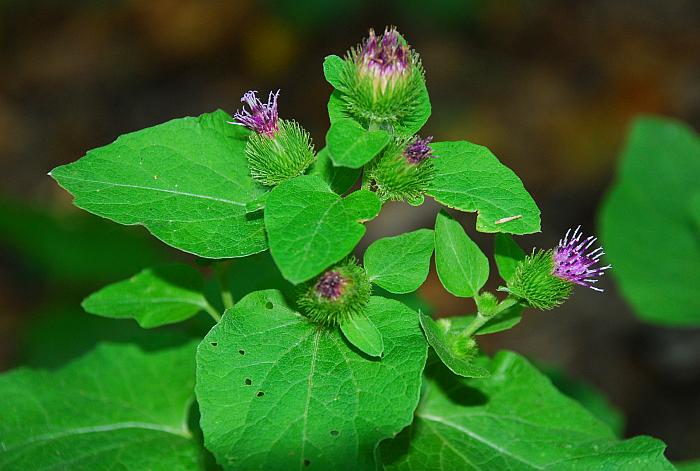Arctium minus (Hill) Bernh.
Common Burdock

Introduced
CC = *
CW = 3
MOC = 36
© SRTurner
Arctium minus (Hill) Bernh.Common Burdock | |
 |
Introduced CC = * CW = 3 MOC = 36 |
© SRTurner |
|
Family - Asteraceae/Cardueae Habit - Large, coarse, biennial forb with stout taproot. Stems - Ascending, to 1.8 m, usually branched, stout, longitudinally ridged, minutely hairy, at least toward the tip, often reddish- or purplish-tinged.
Leaves - Basal and alternate, long-petiolate. Petioles sparsely pubsescent, to 40 cm, with adaxial groove, typically hollow. Basal leaf blades to 60 cm long, ovate, cordate at the base, bluntly or sharply pointed at the tip, the margins irregularly wavy, crisped, or shallowly lobed and often also toothed, the upper surface glabrous or with scattered hairs along the main veins, the undersurface pale-colored, sparsely to moderately pubescent with minute, few-branched hairs, sometimes becoming nearly glabrous with age. Stem leaves progressively smaller toward the tip.
Inflorescence - Inflorescences axillary and terminal, the heads sessile or short-stalked, appearing clustered or more commonly in short, dense racemes. Peduncles tomentose.
Heads - Discoid, the involucre broadly ovoid to nearly spherical, 1.2-2.5 cm in diameter, the florets all perfect. Receptacle flat, with numerous chaff bristles. Involucral bracts 4-13 mm long, the body narrowly lanceolate, appressed-ascending, glabrous or somewhat glandular, tapered to a long, stiff, ascending bristle, this hooked at the tip. Involucre becoming slightly enlarged and globose in fruit.
Florets - Ray florets absent. Disk florets with the corollas 7-9 mm long, pink to purple, glabrous, often somewhat glandular, 5-lobed, the lobes acute, 1.3mm long. Stamens 5, adnate at apex of constricted portion of corolla tube. Filaments white, glabrous, 3.5 mm long. Anthers purple, connate around style, exserted, 3 mm long. Style bifurcate, white, pubescent at base of stigmas. Pappus of several unequal series of short, flattened, bristlelike awns, these 1-3 mm long, with short, ascending barbs, mostly shed individually by fruiting.
Fruits - Achenes to 6 mm long, oblong or slightly narrower at the symmetrical base, somewhat flattened, the surface finely wrinkled, grayish brown with darker mottling. Flowering - July - October. Habitat - Pastures, roadside ditches, low woods, streambanks. Origin - Native to Europe. Lookalikes - None close. Other info. - This coarse plant is found scattered sporadically throughout most of the state, and is found in nearly all of the continental U.S. except Texas and Florida. The combination of large basal leaves and the numerous flowering heads with hooked phyllaries make this plant easy to identify. Though related to the thistles, this species is not spiny. Nevertheless, it's wise to avoid contact with the plant late in the year, as the fruiting heads grab onto nearly everything. Absent humans, the burlike heads are dispersed mainly in animal fur. Photographs taken at Geneva State Park, Geneva, Ohio, 8-4-00, and at Whirlpool State Park, Niagra Falls, NY., 8-6-00 (DETenaglia); also at Weldon Spring Conservation Area, St. Charles County, MO, 9-1-2007, near Labadie, Franklin County, MO, 7-29-2014, and at a highway rest stop near Sutherland, Lincoln County, NE, 8-13-2019 (SRTurner). |